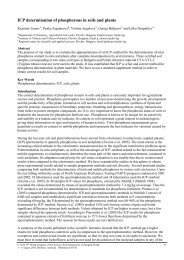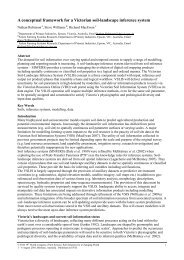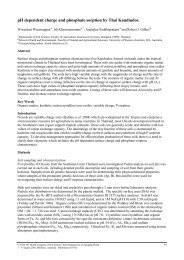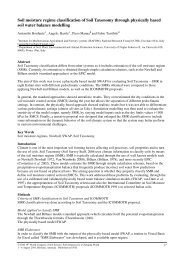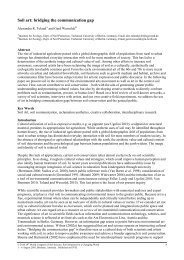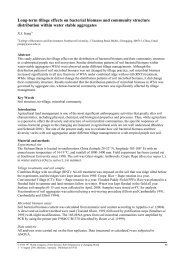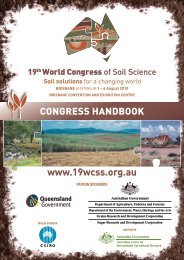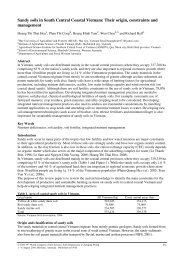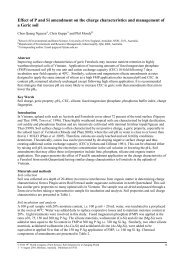Kambala Venkata
Kambala Venkata
Kambala Venkata
You also want an ePaper? Increase the reach of your titles
YUMPU automatically turns print PDFs into web optimized ePapers that Google loves.
Adsorption properties of modified natural materials for the removal of<br />
perfluorochemicals in AFFF wastewater<br />
<strong>Venkata</strong> <strong>Kambala</strong> A,B , Fang Han A,B , Thangavadivel Kandasamy A,B and Ravi Naidu A,B<br />
A Centre for Environmental Risk Assessment and Remediation (CERAR), University of South Australia, Mawson Lakes, SA,<br />
Australia,<br />
B Cooperative Research Centre for Contamination Assessment and Remediation of the Environment (CRC CARE), Mawson Lakes,<br />
SA, Australia, Email venkat.kambala@unisa.edu.au<br />
Abstract<br />
Perfluorooctane sulfonate (PFOS) pollution in water and soil environment is a global problem of concern.<br />
Naturally occurring materials have been prepared by a novel two step modification method. The material has<br />
been named as MatCARE TM (Patent Pending). The sorption behaviour of MatCARE TM was investigated<br />
using batch experiments with technical grade Ansulite (New Aqueous Film Forming Foam product) and<br />
AFFF wastewater. Results showed that MatCARE TM had good selectivity for fluorinated surfactants (PFOS<br />
& Perfluoro octanoicacid) with no influence of other organics and ions present in the AFFF wastewater.<br />
Key Words<br />
Natural materials, modification, wastewater, perfluorochemicals, PFOS and PFOA.<br />
Introduction<br />
Fire suppression systems using AFFF solutions are often installed in facilities containing flammable or<br />
combustible liquids because of the rapid and efficient fire extinguishing capability of foam. Within the<br />
Department of Defence, the primary application of AFFF fire suppression systems is in the facilities housing<br />
fuelled aircraft. Although various types of fire fighting foams are available, AFFF is used almost exclusively<br />
because of its superior fire extinguishing capacity. AFFF formulations contain a class of chemicals known as<br />
perfluorochemicals (PFC) namely PFOS and PFOA. PFC’s are very stable chemicals that do not change or<br />
break down in the environment, or in living things. As a result, they may be found in soil, sediments, water<br />
or in other places. When spilled or disposed of, PFC’s can enter groundwater and easily move long distances,<br />
potentially affecting nearby water supplies. All the constituents resulting from fire fighting exercises are<br />
considered to have adverse environmental effects. The organic constituents in the AFFF have been reported<br />
to resist biodegradation in conventional biological processes as well as contributing to operational problems.<br />
Industrial wastewater has been implicated as a likely prime source of entry of PFOS and PFOA into natural<br />
waters thereby entering domestic water (Schultz et al. 2006). Research efforts; therefore have been directed<br />
towards developing a remediation method for treating AFFF wastewater containing PFC’s.<br />
Naturally occurring materials have found many applications as adsorbents. The capacity of such materials for<br />
the removal of contaminants can be greatly improved by mineral tailoring. Application of tailored materials<br />
offers several advantages, including; low cost of natural materials, versatility in the preparation of selective<br />
and modified materials for target contaminants and availability in abundance. Current work focussed on<br />
preparing and developing an efficient natural material-based adsorbent (MatCARE TM ).<br />
Methods<br />
The fire suppression foam products, 3% and 6% (Ansulite AFFF and AFFF wastewater) were supplied by<br />
the Department of Defence. All other chemicals (analytical standards of PFOS, PFOA) used in this<br />
investigation were purchased from Sigma-Aldrich Ltd. unless otherwise stated. The natural materials were<br />
obtained locally in Australia. Zeolites and MatCARE TM were utilised in the study.<br />
Experimental procedures<br />
Two types of experimental set up have been used to study the adsorption of 3% Ansulite and AFFF<br />
wastewater in the laboratory.<br />
Batch Studies<br />
The adsorption of AFFF technical grades Ansulite (3%) to MatCARE TM (<strong>Kambala</strong> et.al. 2009) was tested in<br />
triplicate by the addition of 20 ml of the usable concentration in various amounts of a sorbent in a 50 ml<br />
© 2010 19 th World Congress of Soil Science, Soil Solutions for a Changing World<br />
1 – 6 August 2010, Brisbane, Australia. Published on DVD.<br />
1
tube. These tubes were rotated for twenty-four hours, centrifuged, filtered and then subjected to analysis by<br />
the methylene blue active substances (MBAS) assay to deduce the amount of usable concentration absorbed.<br />
Analytical methods for detection of AFFF components in water<br />
a) Qualitative Analysis<br />
The MBAS assay is used to qualitatively determine the amount of methylene blue active substances in a<br />
sample by producing a measurable colour change in a separate solvent phase. At acidic pH (pH 2.4)<br />
negatively charged anionic detergents bind methylene blue, becoming hydrophobic and migrating into a<br />
lower chloroform solvent phase producing a colour change. The higher the concentration of anionic<br />
detergents present in a sample, the greater the colour change produced.<br />
b) Quantitative Analysis<br />
Mass spectral detection of the chemical components in AFFF products was achieved with an Agilent 1100<br />
series LC/MSD (Agilent Technologies, USA). A diode array detection (DAD) system was connected in-line<br />
with an electron spray ionisation (ESI) interface. LC separation of surfactants (key ingredients of AFFF) was<br />
carried out with a Zorbax C8 column (C8, 5 µm, 150×4.6 mm, Agilent Technologies, USA).<br />
Results<br />
Effect of adsorbent dosage in batch studies<br />
In the batch study it is essential to find the optimum adsorbent dose of the modified natural material and also<br />
contact time for maximum removal of contaminants. A series of 20 ml samples of Ansulite and AFFF<br />
wastewater were shaken for 2-20 hrs with adsorbent doses ranging from 0.5-1g. The initial concentrations of<br />
technical grade ansulite were made up of 3% solutions (97ml water and 3 ml Ansulite). It has been observed<br />
that the removal of ansulite increased with the increase in adsorbent dosage as shown in Figure 1. The<br />
removal of ansulite at an adsorbent dosage of 1g was found to be 96%. Hence, 1g was selected as the best<br />
dosage of adsorbent. The removal efficiency of AFFF wastewater is presented in figure 2. It is clearly shown<br />
that the dose of adsorbent and time was significantly less for 99% removal of contaminants in AFFF<br />
wastewater.<br />
Figure 1. The removal efficiency of Ansulite (3%) using MatCARE TM .<br />
1g<br />
0.5g<br />
Figure 2. The removal efficiency of AFFF wastewater using MatCARE TM<br />
© 2010 19 th World Congress of Soil Science, Soil Solutions for a Changing World<br />
1 – 6 August 2010, Brisbane, Australia. Published on DVD.<br />
2
Conclusion<br />
Modified natural materials can be used for the remediation of Ansulite and AFFF wastewater. In a batch<br />
study the optimum adsorbent dosage and equilibrium time for Ansulite was found to be 1g and 20 h<br />
respectively. In the case of AFFF wastewater the optimum dose was between 0.5-1g with an equilibrium<br />
time of 2h. Under optimised conditions, 96% of Ansulite and 98% of AFFF wastewater could be remediated<br />
using MatCARE TM . Column in series design could be used for better performance of MatCARE TM . After<br />
exhaustion of the modified material it could be used for the removal of other organic pollutants like dyes etc.<br />
from the wastewater, or it could efficiently be regenerated by subjecting it to different treatments for its<br />
further use with a fresh lot of AFFF wastewater. Pilot scale remediation trials are in progress to treat large<br />
volumes of AFFF wastewater.<br />
Acknowledgments<br />
This project (6-10-01-08/09) is funded by CRC CARE and supported by Department of Defence, Australia.<br />
References<br />
Schultz MM, Barofsky DF, Field JA (2006) Quantitative determination of fluorinated alkyl substances by<br />
large-volume- injection liquid chromatography tandem mass spectrometry- Characterization of municipal<br />
wastewaters. Environ. Sci. Techno. 40, 289-95.<br />
<strong>Kambala</strong> V, Naidu R (2009) Tailored natural materials for the remediation of perfluorochemicals in soil and<br />
wastewater (Australian Provisional Patent in Progress).<br />
© 2010 19 th World Congress of Soil Science, Soil Solutions for a Changing World<br />
1 – 6 August 2010, Brisbane, Australia. Published on DVD.<br />
3



